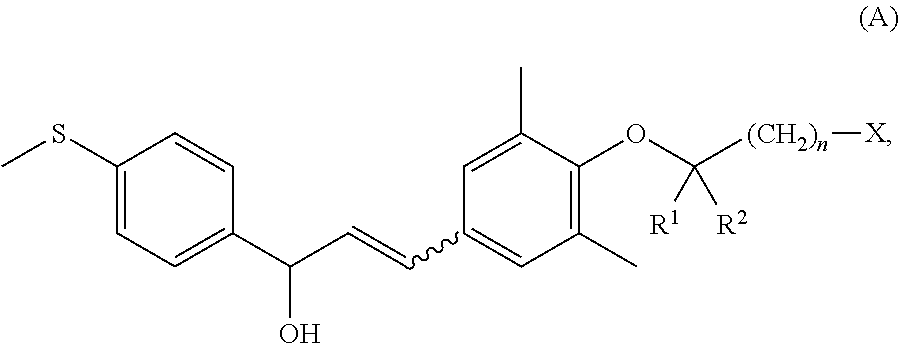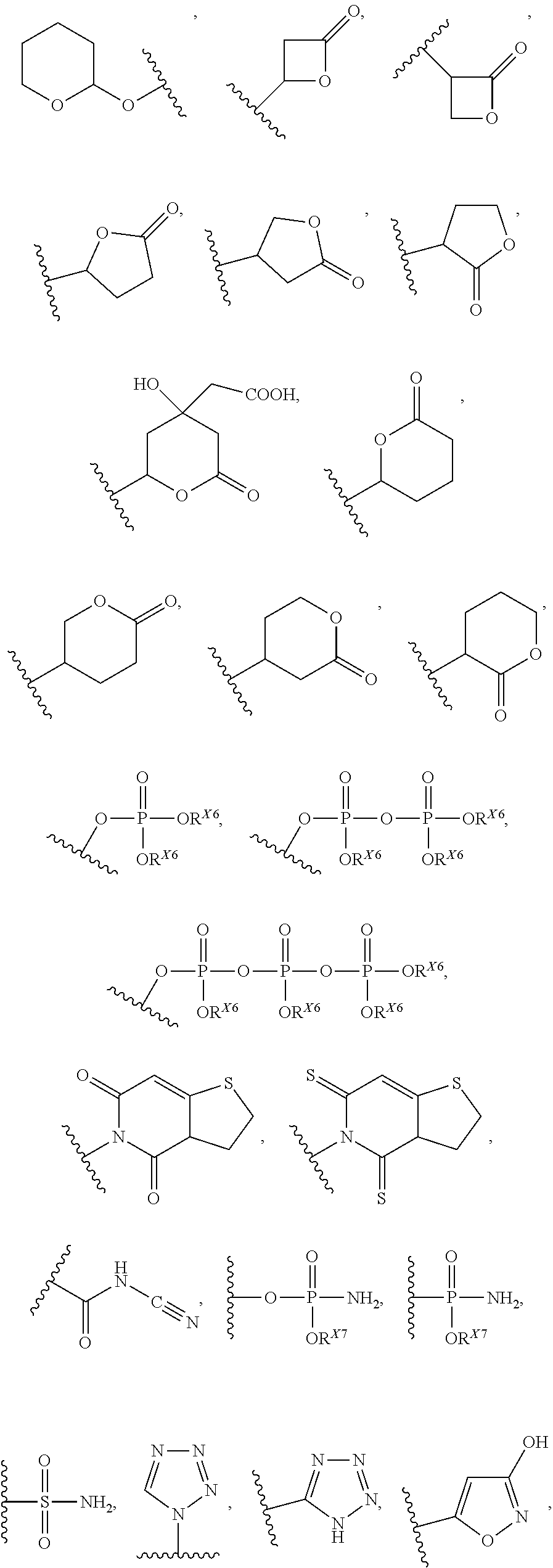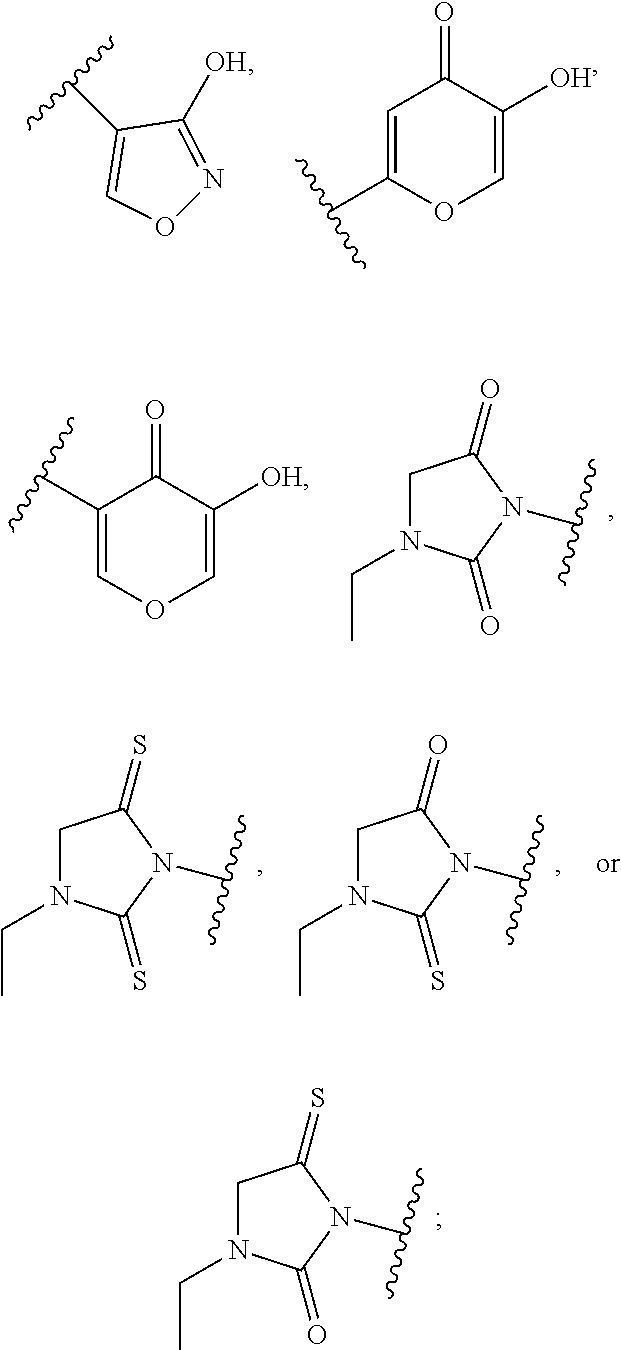Compounds Useful for Treating Liver Diseases
a technology for liver diseases and compounds, applied in the field of compounds, can solve the problems of low ti, inability to achieve effective doses, and limited clinical use of ppar agonists such as elafibranor, and achieve the effects of improving therapeutic index, bioavailability and/or half-life and/or safety, and improving therapeutic index
- Summary
- Abstract
- Description
- Claims
- Application Information
AI Technical Summary
Benefits of technology
Problems solved by technology
Method used
Image
Examples
embodiment 1
[0809]2. The compound or pharmaceutically acceptable salt, solvate, ester, amide, or prodrug of the compound of embodiment 1, wherein the compound is a racemate or a mixture of enantiomers or diastereomers.
[0810]3. The compound or pharmaceutically acceptable salt, solvate, ester, amide, or prodrug of the compound of embodiment 1, wherein the compound has an hydroxyl-bearing allylic carbon atom having an (R)-stereochemistry and has the structure
[0811]4. The compound or pharmaceutically acceptable salt, solvate, ester, amide, or prodrug of the compound of embodiment 1, wherein the compound has an hydroxyl-bearing allylic carbon atom having an (S)-stereochemistry and has the structure
[0812]5. The compound or pharmaceutically acceptable salt, solvate, ester, amide, or prodrug of the compound of embodiment 3 or 4, wherein the compound is substantially free of its corresponding opposite stereoisomer.
[0813]6. The compound or pharmaceutically acceptable salt, solvate, ester, amide, or prodr...
embodiment 16
[0831]18. The compound or pharmaceutically acceptable salt, solvate, ester, amide, or prodrug of the compound of embodiment 16, wherein the compound is a (Z)-isomer and has the structure
[0832]19. The compound or pharmaceutically acceptable salt, solvate, ester, amide, or prodrug of the compound of embodiment 16, wherein the compound is a (E)-isomer and has the structure
[0833]20. The compound or pharmaceutically acceptable salt, solvate, ester, amide, or prodrug of the compound of embodiment 18 or 19, wherein the compound is substantially free of its corresponding other olefin configuration.
[0834]21. The compound or pharmaceutically acceptable salt, solvate, ester, amide, or prodrug of the compound of any one of embodiments 16-20, wherein each R1 and R2 is independently —C1_C3 alkyl.
[0835]22. The compound or pharmaceutically acceptable salt, solvate, ester, amide, or prodrug of any one of embodiments 16-20, wherein each R1 and R2 is independently methyl.
[0836]23. The compound or phar...
embodiment 26
[0840]27. The compound or pharmaceutically acceptable salt, solvate, ester, amide, or prodrug of the compound of embodiment 26, wherein the compound is a racemate or a mixture of enantiomers.
[0841]28. The compound or pharmaceutically acceptable salt, solvate, ester, amide, or prodrug of the compound of embodiment 26, wherein the compound has an hydroxyl-bearing allylic carbon atom having an (R)-stereochemistry and has the structure
[0842]29. The compound or pharmaceutically acceptable salt, solvate, ester, amide, or prodrug of the compound of embodiment 26, wherein the compound has an hydroxyl-bearing allylic carbon atom having an (S)-stereochemistry and has the structure
[0843]30. The compound or pharmaceutically acceptable salt, solvate, ester, amide, or prodrug of the compound of embodiment 28 or 29, wherein the compound is substantially free of its corresponding opposite enantiomer.
[0844]31. The compound or pharmaceutically acceptable salt, solvate, ester, amide, or prodrug of the...
PUM
| Property | Measurement | Unit |
|---|---|---|
| Composition | aaaaa | aaaaa |
| Concentration | aaaaa | aaaaa |
| Density | aaaaa | aaaaa |
Abstract
Description
Claims
Application Information
 Login to View More
Login to View More - R&D
- Intellectual Property
- Life Sciences
- Materials
- Tech Scout
- Unparalleled Data Quality
- Higher Quality Content
- 60% Fewer Hallucinations
Browse by: Latest US Patents, China's latest patents, Technical Efficacy Thesaurus, Application Domain, Technology Topic, Popular Technical Reports.
© 2025 PatSnap. All rights reserved.Legal|Privacy policy|Modern Slavery Act Transparency Statement|Sitemap|About US| Contact US: help@patsnap.com



